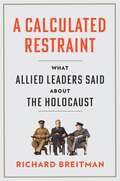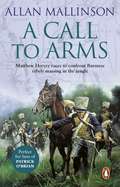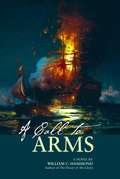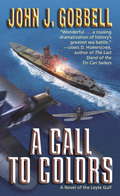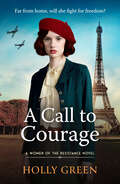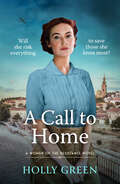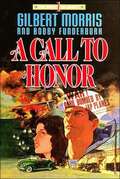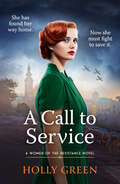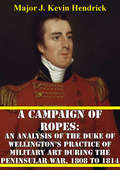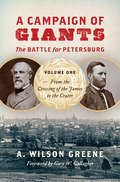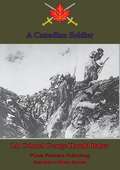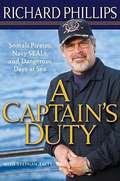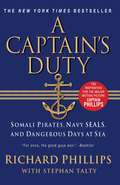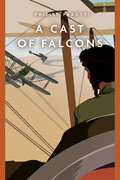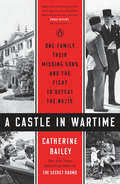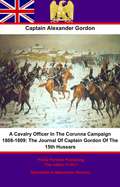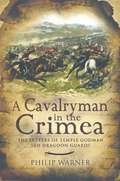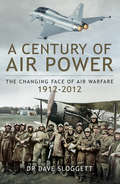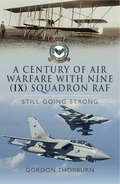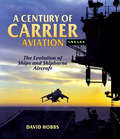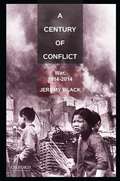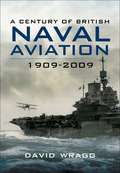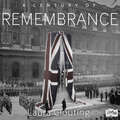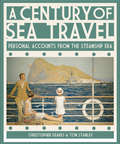- Table View
- List View
A Calculated Restraint: What Allied Leaders Said about the Holocaust
by Richard BreitmanAn eminent historian of the Holocaust examines why Churchill, Roosevelt, and Stalin, though faced with mounting evidence of the Nazi extermination of Jews, were reluctant to speak out against the atrocities.The Allied leaders rarely spoke directly about the Holocaust in public. When Churchill and Stalin alluded to Nazi mass murder of civilians in early speeches, they said much less than they knew. Not until December 1942 did Allied governments issue a joint statement about Nazi Germany’s policy of exterminating the Jews of Europe. Roosevelt deferred his own public statement until March 1944. Why didn’t these leaders speak up sooner?Through close readings of public and private statements, Richard Breitman pieces together the competing motivations that drove each leader’s response to the atrocities. All three knew that their reactions would be politically sensitive, as Nazi propagandists frequently alleged that the Allies were fighting on behalf of Jews, and that Jews were the puppet masters behind their governments. At a time of globally prevalent antisemitism, these calumnies had force. After the German invasion of the USSR, moreover, Stalin clearly wanted to focus on the threat to the Soviet state and people. At the same time, Churchill and Roosevelt realized that complete silence would prompt accusations of willful blindness. They usually finessed this dilemma by denouncing Nazi atrocities in general, prioritizing wartime constraints over moral considerations.Timely and incisive, A Calculated Restraint sheds new light on the relationship between World War II and the Holocaust. Ultimately, the Allied leaders’ responses cannot be reduced to a matter of character. What they said—and chose not to say—about the Holocaust must be understood in light of the political and military exigencies that drove their decision-making.
A Call To Arms: (The Matthew Hervey Adventures: 4): A rip-roaring and fast-paced military adventure from bestselling author Allan Mallinson (Matthew Hervey #4)
by Allan MallinsonThe Sunday Times bestselling author Allan Mallinson, brings us another action-packed and stirring Matthew Hervey adventure. If you like Patrick O'Brian, Bernard Cornwell and CS Forester, this will not disappoint!"A thoroughly satisfying and entertaining read" - THE TIMES"Matthew Hervey has now joined Bernard Cornwell's Sharpe and Patrick O'Brian's Jack Aubrey" - Birmingham Post"After just half-a-dozen pages I was hooked." -- ***** Reader review"An excellent book, when you start reading you cannot put it down. Allan Mallinson at his best!!!" -- ***** Reader review"Essential reading for military buffs" -- ***** Reader review**********************************************************************India 1819: Matthew Hervey is charged with raising a new troop, and organising transport for India - for he, his men and their horses are to set sail with immediate effect.What Hervey and his soldiers cannot know is that in India they will face a trial for which they are woefully under prepared. A large number of Burmese war-boats are assembled near Chittagong, and the only way to thwart their advance involves a hazardous march through the jungle. Soon Hervey and his troop are in the midst of hot and bloody action once again...A Call To Arms is the fourth book in Allan Mallinson's Matthew Hervey series. His adventures continue in The Sabre's Edge. Have you read his previous adventures A Close Run Thing, The Nizam's Daughters and A Regimental Affair?
A Call to Arms
by William C. HammondCall To Arms is the fourth novel in the award-winning historical / nautical fiction series from William C. Hammond. Along with the other novels in the Cutler Family Chronicles - most recently For Love of Country and The Power and the Glory - it features the epic saga of the seafaring Cutler family of Hingham, Massachusetts and an ever expanding cast of characters. Among these characters are real historical figures including Capt. Edward Preble, Lt. Stephen Decatur, Lt. Richard Somers, Samuel Coleridge, Bashaw Yusuf Qaramanli, and Adm. Horatio Lord Nelson. Interwoven with these historical characters is a fast-paced and gripping plot that takes the reader from Java in the Dutch East Indies to New England at the start of the nineteenth century, and on to Gibraltar, Tripoli, Malta, Sicily, Alexandria and Cairo. Historic events depicted in the novel have been subjected to intense research and have been vetted by historians.
A Call to Colors: A Novel of the Leyte Gulf
by John J. GobbellAmong them is the destroyer USS Matthew and her skipper, Commander Mike Donovan, a veteran haunted by earlier savage battles. What Donovan doesn't know is that Vice Admiral Takao Kurita of Japan has laid an ingenious trap as the Matthew heads for the treacherous waters of Leyte Gulf. But Donovan faces something even deadlier than Kurita's battleships: Explosives secretly slipped on board American ships by saboteurs are set to detonate at any time. Now the Matthew's survival hinges on the ability of Donovan and his men to dismantle a bomb in the midst of the panic and the chaos of history's greatest naval battle.
A Call to Courage: A powerfully captivating and romantic WW2 saga (Women of the Resistance)
by Holly GreenFar from home, will she fight for freedom? 21-year-old Alix is studying in Paris, far away from Sasha, her Serbian father and Leonora, her English mother, as World War Two breaks out. Finding hope even in troubled times, romance sparks with fellow student Raoul; but she soon learns young love can be tumultuous. So, when Steve, a handsome American pilot with Serbian ancestors, enters her life, she can’t ignore her feelings toward him. And making a decision will be even harder as both men leave for war… Meanwhile, in Belgrade her father is embroiled in a plot against the Prince Regent, while her mother begins to work with the Nursing Corps in Finland. Life in Paris grows perilous under the oppressive German occupation, and Alix is faced with an impossible choice: run for home, or stay and join the Resistance. Can she find the courage to risk her life for freedom? Meet the characters from Holly Green’s Frontline Nurses series, in this captivating new historical read set in Paris during WW2. Fans of Amanda Lees and Suzanne Kelman will love this. Readers are absolutely hooked: ‘So well written… felt so real. Everything about it made for a great read. I recommend this and give it 5 stars.’ ***** Reader Review ‘A fantastic story … The characters capture your attention right from the very first page.' ***** Reader Review ‘The story had me hooked from the beginning … highly recommend’ ***** Reader Review ‘Great book by this author … felt like I was in the story’ ***** Reader Review Praise for Holly Green: ‘Holly Green’s research and delivery of her stories gives readers a glimpse of the reality of war.’ ***** Reader Review ‘Holly’s storytelling is amazing, you feel you are actually there.’ ***** Reader Review
A Call to Home: A captivating, romantic and poignant WW2 novel (Women of the Resistance)
by Holly GreenWill she risk everything, to save those she loves most? Alix has always been on the side of the Resistance. Over two years of danger and suffering, she has continued the fight alongside her comrades in the Partisans. But while facing constant threat, her personal relationships, with Nikola – the man she was supposed to marry – and Drago, her lifelong friend, are complicated. Working with the rival Chetniks is Steve, the American pilot who is never far from Alix’s mind. Despite wanting the same peaceful outcome, they remain on opposite sides. The hope of a reunion seems unlikely, but nothing is ever predictable in love and war… Featuring characters from Holly Green’s Frontline Nurses series, this gripping new historical read spans Europe during World War Two. Fans of Amanda Lees and Fiona Valpy will love this captivating wartime romance. Readers love Holly Green’s Women of the Resistance series: 'I was captured from the beginning as the characters were instantly familiar.'***** Reader Review ‘So well written… felt so real. Everything about it made for a great read. I recommend this and give it 5 stars.’ ***** Reader Review ‘A fantastic story … The characters capture your attention right from the very first page.’ ***** Reader Review ‘The story had me hooked from the beginning … highly recommend’ ***** Reader Review ‘Great book by this author … felt like I was in the story’ ***** Reader Review ‘A brilliantly written and well researched book.’ ***** Reader Review ‘Holly’s storytelling is amazing, you feel you are actually there.’ ***** Reader Review ‘Holly Green’s research and delivery of her stories gives readers a glimpse of the reality of war.’ ***** Reader Review
A Call to Honor (The Price of Liberty #1)
by Gilbert Morris Bobby FunderburkBen Logan was filled with impossible dreams of success and far-off adventure. Always one of the "have-nots" in the small class-conscious town of Liberty, Georgia, he was alternately tolerated and rejected by those that called him "poor white trash" and ridiculed his father, an often-drunk pulpwood cutter. Part of Ben's dream comes true when the daughter of the richest man in town invites him into her self-centered world. Ben is haunted by the memory of her kiss, the soft wetness of her lips against his neck, her fragrance, and her unbearably blue eyes. But when circumstances force Ben to leave Liberty and join the Navy, the memory of that kiss goes with him, erasing thoughts of the other young woman he left behind: Rachel, the thin, freckle-faced daughter of a poor Pentecostal preacher. "God told me I'm going to be your wife," Rachel told Ben on the day he left Liberty. "Are you crazy" Ben scoffed at her. "I'd never marry you in a hundred years!" But everything changed--everything--on December 7,1941, when Ben Logan found himself in Pearl Harbor, leaning into a gun mount on the deck of the USS Arizona...
A Call to Service: An engrossing, powerful and heart-breaking WW2 novel (Women of the Resistance)
by Holly GreenHer country needs her. But her heart is elsewhere.After fleeing German-occupied Paris, Alix is back in her home in Belgrade, hoping to finally reunite with her parents. But while Alix has been fighting her own battles with the Resistance, her parents have too fled with King Peter to ensure his safety. As Alix decides to find her parents with her father's deputy steward, Drago, they are derailed and forced to reside in the Serbian country home.But all is not lost when Alix finds Nikola in the city - the man her father said she was to marry before war broke out. She finds she has more in common with him than ever expected, and together with Drago they join a new Resistance.But Alix hasn't forgotten about Steve, the handsome American pilot she fell in love with back in France, whom she last heard was harmed in battle. When a chance meeting brings Alix and Steve face to face once again, she must decide where her heart truly isFans of Suzanne Kelman and Fiona Valpy will love this captivating, globe-trotting, deeply rich historical fiction set in World War Two.Readers are loving A Call to Service:'A wonderful story of romance, adventure, and resistance. I can't wait to read the next book! I want more!' Reader Review'This was such a great historical book. I absolutely loved the story it was very well researched and the pacing was great!' Reader ReviewPraise for Holly Green:'So well written felt so real. Everything about it made for a great read. I recommend this and give it 5 stars.' Reader Review'A fantastic story The characters capture your attention right from the very first page.' Reader Review'The story had me hooked from the beginning highly recommend' Reader Review'Great book by this author felt like I was in the story' Reader Review'A brilliantly written and well researched book.' Reader Review'Holly's storytelling is amazing, you feel you are actually there.' Reader Review'Holly Green's research and delivery of her stories gives readers a glimpse of the reality of war.' Reader Review
A Campaign Of Ropes: An Analysis Of The Duke Of Wellington’s Practice Of Military Art During The Peninsular War, 1808 To 1814
by Major J. Kevin HendrickThe purpose of this paper was to study the practice of military art at the operational level of war. The story of Wellington's ultimate success against Napoleon's Marshals was selected as a case study as it seemed rich in the application of mental agility to achieve an asymmetrical military advantage in a theater of war. As military theory recognizes two general types of military art, classical strategy and operational art, the research question was constructed to determine if Wellington practiced pure classic strategy, or an early/transitional form of operational art.In order to provide a basis of analysis, the essential elements of both classic strategy and operational art are next defined. The history of classic strategy is outlined, then the theory of Clausewitz and Jomini used to define its four basic elements. The practice of operational art is then traced, from its inception by U.S. Grant during the American Civil War, to Soviet operational theory developed in the 1920's. The theory of Dr. James Schneider, a primary interpreter of both Grant and the Soviets, provides the eight essential elements of operational art. To round out the section on military art, U.S. operational doctrine is outlined and discussed.Like most military officers, Wellington was a creature of his own experience, therefore a chapter is dedicated to the lessons he learned as a young officer in India. The following chapter is dedicated to a study of the Peninsular War. As the research question deals with both the operational and strategic levels of war, Wellington's tactics are neglected in favor of his campaign concepts and execution.
A Campaign of Giants--The Battle for Petersburg: Volume 1: From the Crossing of the James to the Crater (Civil War America)
by A. Wilson GreeneGrinding, bloody, and ultimately decisive, the Petersburg Campaign was the Civil War's longest and among its most complex. Ulysses S. Grant and Robert E. Lee squared off for more than nine months in their struggle for Petersburg, the key to the Confederate capital at Richmond. Featuring some of the war's most notorious battles, the campaign played out against a backdrop of political drama and crucial fighting elsewhere, with massive costs for soldiers and civilians alike. After failing to bull his way into Petersburg, Grant concentrated on isolating the city from its communications with the rest of the surviving Confederacy, stretching Lee's defenses to the breaking point. When Lee's desperate breakout attempt failed in March 1865, Grant launched his final offensives that forced the Confederates to abandon the city on April 2, 1865. A week later, Lee surrendered at Appomattox Court House.Here A. Wilson Greene opens his sweeping new three-volume history of the Petersburg Campaign, taking readers from Grant's crossing of the James in mid-June 1864 to the fateful Battle of the Crater on July 30. Full of fresh insights drawn from military, political, and social history, A Campaign of Giants is destined to be the definitive account of the campaign. With new perspectives on operational and tactical choices by commanders, the experiences of common soldiers and civilians, and the significant role of the United States Colored Troops in the fighting, this book offers essential reading for all those interested in the history of the Civil War.
A Canadian Soldier
by Lt. Colonel George Harold Baker M.P.Lt.-Col. Baker was born into a family with a long history of service to Canada: his father had served in the Provincial Legislature or the Dominion Parliament for over forty years. Colonel Baker, a man of many interests, undertook law at McGill University and was called to the Bar in 1900. After a successful career, which included a stint as a member of Parliament, his military career started in the cavalry gazetted as a provisional lieutenant in the 6th Hussars, and by 1913 he was Lt.-Colonel of the 13th Scottish Light Dragoons. With the gathering of the clouds over Europe, Colonel Baker steeled himself for field service and responded to a toast to his health: "my aim is to win, if possible, the confidence of my men and to leave the rest to circumstance and the turn of events."His military career was to be of great merit but short in duration, like many of his comrades-in-arms who travelled from the furthest Dominions to Flanders Fields. His story is told in his collection of letters, and a copy of the despatch that memorialises his death; but suffice to say that they are a telling recollection of an upright, honourable soldier, loved by his men, conscientious to his duty, who lay down his life for his country.Author -- Lt. Colonel George Harold Baker M.P. d. 1916Text taken, whole and complete, from the edition privately published.Original Page Count - 83Illustrations -- 3 Portraits
A Captain's Duty: Somali Pirates, Navy SEALs, and Dangerous Days at Sea
by Richard Phillips Stephan TaltyIt was just another day on the job for Richard Phillips, captain of the Maersk Alabama, the United States-flagged cargo ship that was carrying, among other things, food and agricultural materials for the World Food Program. That all changed when armed Somali pirates boarded the ship. The pirates didn't expect the crew to fight back, nor did they expect Captain Phillips to offer himself as hostage in exchange for the safety of his crew. Thus began the tense five-day standoff that ended in a daring high-seas rescue when U.S. Navy SEALs opened fire and picked off three of the captors. "It never ends like this," Captain Phillips said. And he's right. "A Captain's Duty" tells the life-and-death drama of the career sailor who was held captive on a tiny lifeboat off Somalia's anarchic, gun-plagued shores. A story of adventure and courage it provides the intimate details of this high-seas hostage-taking--the unbearable heat, the death threats, the mock executions, and the escape attempt. When the pirates boarded his ship, Captain Phillips put his experience into action, doing everything he could to safeguard his crew. And when he was held captive by the pirates, he marshaled all his resources to ensure his own survival, withstanding intense physical hardship and an escalating battle of wills. This was it: the moment where training meets instinct, where character is everything. Richard Phillips was ready.
A Captain's Duty: Somali Pirates, Navy SEALs, and Dangerous Days at Sea
by Richard Phillips Stephan Talty"I share the country's admiration for the bravery of Captain Phillips and his selfless concern for his crew. His courage is a model for all Americans."--President Barack Obama It was just another day on the job for fifty-three-year-old Richard Phillips, captain of the Maersk Alabama, the United States-flagged cargo ship which was carrying, among other things, food and agricultural materials for the World Food Program. That all changed when armed Somali pirates boarded the ship. The pirates didn't expect the crew to fight back, nor did they expect Captain Phillips to offer himself as hostage in exchange for the safety of his crew. Thus began the tense five-day stand-off, which ended in a daring high-seas rescue when U.S. Navy SEALs opened fire and picked off three of the captors. "It never ends like this," Captain Phillips said. And he's right. A Captain's Duty tells the life-and-death drama of the Vermont native who was held captive on a tiny lifeboat off Somalia's anarchic, gun-plagued shores. A story of adventure and courage, it provides the intimate details of this high-seas hostage-taking--the unbearable heat, the death threats, the mock executions, and the escape attempt. When the pirates boarded his ship, Captain Phillips put his experience into action, doing everything he could to safeguard his crew. And when he was held captive by the pirates, he marshaled all his resources to ensure his own survival, withstanding intense physical hardship and an escalating battle of wills with the pirates. This was it: the moment where training meets instinct and where character is everything. Richard Phillips was ready.
A Cast of Falcons (Casemate Fiction)
by Phillip Parotti"Casemate has a long history of publishing high quality military history non-fiction. Lately, they have expanded their range of work to include well written novels using wartime settings." – WWII History MagazineYoung pilots of the Royal Flying Corps take to the air above the Sinai desert in 1916 to fight German pilots flying far superior aircraft. Will their determination and aggressive spirit be enough to prevail?Phillip Parotti’s new novel offers fast-paced action in the skies over the Sinai desert in 1916. Lieutenant Devlin Collins, an Irish-American flier in the Royal Flying Corps, expecting to fly on the Western Front, instead finds himself flying antiquated two-seater bomber and photo reconnaissance missions over the Egyptian desert against the forces of the Central Powers which are trying to capture the Suez Canal. Pitted against German machines which are up-to-date and well equipped, the men of the RFC fight at a considerable disadvantage as they go forth to meet their enemy, but committed to their cause and with aggressive spirit, no matter how great the stress of battle, they proceed and prevail, continually forcing the Turks and Germans back as the army moves slowly toward Palestine. Constantly endangered by superior German machines, facing incessant ground fire during their bombing and strafing attacks, Dev and his fellow pilot Crisp drive home their attacks with unremitting determination. In the off hours from combat, Dev discovers that he has a particular talent for planning his flight’s air raids. This talent manifests itself completely in the campaign’s culminating attack on the German redoubts at the battle of Magdhaba, an attack so successful that when the pilots are finally pulled back for a rest after a year of fighting, Dev is promoted and invited onto the staff at GHQ is order to apply his expertise to air planning as the army moves on Gaza with the intention of driving into Palestine.
A Castle in Wartime: One Family, Their Missing Sons, and the Fight to Defeat the Nazis
by Catherine Bailey"I was gripped by A Castle in Wartime--it contained more tension, more plot in fact--than any thriller."--Kate Atkinson, author of Big Sky and Case HistoriesAn enthralling story of one family's extraordinary courage and resistance amidst the horrors of war from the New York Times bestselling author of The Secret Rooms.As war swept across Europe in 1940, the idyllic life of Fey von Hassell seemed a world away from the conflict. The daughter of Ulrich von Hassell, Hitler's Ambassador to Italy, her marriage to Italian aristocrat Detalmo Pirzio-Biroli brought with it a castle and an estate in the north of Italy. Beautiful and privileged, Fey and her two young sons lead a tranquil life undisturbed by the trauma and privations of war. But with Fascism approaching its zenith, Fey's peaceful existence is threatened when Ulrich and Detalmo take the brave and difficult decision to resist the Nazis.When German soldiers pour over the Italian border, Fey is suddenly marooned in the Nazi-occupied north and unable to communicate with her husband, who has joined the underground anti-Fascist movement in Rome. Before long, SS soldiers have taken up occupancy in the castle. As Fey struggles to maintain an air of warm welcome to her unwanted guests, the clandestine activities of both her father and husband become increasingly brazen and openly rebellious. Darkness descends when Ulrich's foiled plot to kill the Fuhrer brings the Gestapo to Fey's doorstep. It would be months before Detalmo learns that his wife had been arrested and his two young boys seized by the SS. Suffused with Catherine Bailey's signature atmospheric prose, A Castle in Wartime tells the unforgettable story of the extraordinary bravery and fortitude of one family who collectively and individually sacrificed everything to resist the Nazis from within. Bailey's unprecedented access to stunning first-hand family accounts, along with records from concentration camps and surviving SS files, make this a dazzling and compulsively readable book, opening a view on the cost and consequences of resistance.
A Cat In The Ghetto, Four Novelettes
by Rachmil Bryks"One should read it in order not to forget."--Eleanor RooseveltFirst published in English in 1959 and long unavailable, Rachmil Bryks's vivid stories portray Jewish life in the Lodz ghetto and at Auschwitz. In a spare and tragicomic style, they illuminate the small and large absurdities that arise at the limits of human endurance--from the cooking of "roast meat" made of cabbage leaves to the predicament of Jews forced to cooperate in the hierarchy of their own annihilation. Deceptively simple and often humorous, these stories nevertheless mirror Bryks's nuanced view of major moral dilemmas of the period: action vs. inaction, preserving dignity vs. survival.--Print Ed.
A Cavalry Officer In The Corunna Campaign 1808-1809: The Journal Of Captain Gordon Of The 15th Hussars
by Captain Alexander GordonThis ebook is purpose built and is proof-read and re-type set from the original to provide an outstanding experience of reflowing text for an ebook reader. Captain Gordon led a troop of the 15th Hussars during the first of the British army's campaigns into Spain, commanded by Sir John Moore. Unearthed and published many years after it was written by the esteemed Regimental historian Colonel Wylly, his diary bears testimony to the events of the retreat to Corunna. Gordon writes of his adventures with verve, wit and in some places a little venom when talking of his erstwhile commander Moore; he is fulsome in his description of the Portuguese and Spanish people to whom the British had come to aid. For example when relating the qualities of a local wine he could "only compare the taste of it to a mixture of vinegar and ink" On military matters he is no great respecter of rank, and distributes blame and praise where he believes they should be rightly apportioned. He gives a great first-hand account of the famed skirmish of Sahagun, to which he believes started a moral ascendancy of the British cavalry over their French counterparts. Despite some defective equipment and, as Gordon attributes it, dilatory conduct by the commander, he reaches Corunna unlike a number of his comrades and fellow country-men. A fine read, which despite its format as a journal retains some pace, it gives a great view of the retreat from an expert military eye. Text taken, whole and complete from the 1913 edition, John Murray, London Original -238 pages Author - Captain Alexander Gordon (1781-1872) Editor - Colonel Harold Carmichael Wylly (1858-1932) Illustrations - 1 portrait, 2 plans, 1 map not included because of size [A3] Linked TOC
A Cavalryman in the Crimea: The Letters of Temple Godman, 5th Dragoon Guards
by Philip WarnerAmong the British troops bound for the Black Sea in May 1854 was a young officer in the 5th Dragoon Guards, Richard Temple Godman, who sent home throughout the entire Crimea campaign many detailed letters to his family at Park Hatch in Surrey. Temple Godman went out at the start of the war, took part in the successful Charge of the Heavy Brigade at Balaklava and in other engagements, and did not return to England until June 1856, after peace had been declared. He took three very individual horses and despite all his adventures brought them back unscathed.Godmans dispatches from the fields of war reveal his wide interests and varied experiences; they range from the pleasures of riding in a foreign landscape, smoking Turkish tobacco, and overcoming boredom by donning comic dress and hunting wild dogs, to the pain of seeing friends and horses die from battle, disease, deprivation and lack of medicines.He writes scathingly about the skein of rivalries between the Generals (a good many muffs among the chiefs), inaccurate and highly coloured newspaper reports and, while critical of medical inefficiency, regards women in hospitals as a sort of fanaticism. Yet at other times he will employ the pen of an artist in describing a scene, or wax eloquent on the idiosyncrasies of horses. He is altogether a most gallant and sensitive young cavalryman, and deservedly went on to achieve high rank after the war. Always fresh and easy to read, his letters provide an unrivalled picture of what it was really like to be in the Crimea.
A Century of Air Power: The Changing Face of Warfare, 1912–2012
by Dr. Dave SloggettAn extensive history of the first century of aerial warfare, covering the every major conflict including the two world wars. No other technical development since the introduction of gunpowder has had as great an influence on warfare as the aircraft. From its early beginnings as simply a means of aerial reconnaissance to its utter supremacy on the battlefield, the aircraft has evolved into the most versatile and precise killing machine known to man. In this wide-ranging and comprehensive study, David Sloggett, an internationally-respected defence analyst, investigates the changing role and increasing significance of air power over the course of the previous 100 years. This is accomplished by detailing every major conflict during that period including not only the two world wars and the recent conflicts in the Middle East but also the Korean War, the Cuban Missile Crisis, the Falklands War and Russian use of air power in Afghanistan. Air power&’s role in Malaya, Oman, Kenya and in Northern Ireland is also explained.A Century of Air Power is the most important study of the use of military aircraft ever undertaken and as such provides valuable lessons for the future—not only for the commanders who have to apply these all-powerful weapons but also for the politicians who have to determine its use.
A Century of Air Warfare With Nine (IX) Squadron, RAF: Still Going Strong
by Gordon ThorburnIn the earliest days of World War One, when IX Squadron was formed, we went to the fight in little 50mph machines that were barely capable of taking pilot and observer, a gun and a few small, hand-held bombs into the sky, especially on a windy day. When we took a wireless set, to spot for the artillery and report on troop movements, the extra load forced the defenceless pilot to leave his observer behind.A century later, IX (B) Squadron flies jets that can exceed the speed of sound, place laser-guided missiles within a few centimetres of the target, and transmit the most complex data in real time across the globe.In between, the tale is of ponderous beasts of biplanes, of Wellingtons and Lancasters in the bloody battles of World War Two, of Canberras and Vulcans in the nuclear age of the Cold War.Above all, it's the story of the men and women of the RAF's senior bomber squadron across a hundred years of war and peace, and their words fill this book. We go from those beginnings in wood, wire and fabric kites over France and a pilot armed with a service revolver, to the world's first Tornado squadron in the Gulf wars, over Kosovo and Afghanistan, and so to the present, a century on.It really is one hell of a story.
A Century of Carrier Aviation: The Evolution of Ships and Shipborne Aircraft
by David HobbsIt is now almost exactly a hundred years since a heavier-than-air craft first took off and landed on a warship, and from the very beginning flying at sea made unique demands on men and machines. As warplanes grew larger, faster and heavier, air operations from ships were only possible at all through constant development in technology, techniques and tactics. This book charts the progress and growing effectiveness of naval air power, concentrating on the advances and inventions - most of them British - that allowed shipborne aircraft to match their land-based counterparts, and looking at their contribution to 20th century warfare. Written by a retired Fleet Air Arm pilot and and award-winning historian of naval flying, this is a masterly overview of the history of aviation in the world's navies down to the present day. Heavily illustrated from the author's comprehensive collection of photographs, the book will be essential reading to anyone with an interest in navies or air power.
A Century of Conflict: War, 1914-2014
by Jeremy Black<p>The centenary of the start of World War One in 1914 provides an opportunity to assess the role and impact of conflict in the history of the last century, and also to consider how warfare has changed. A Century of Conflict offers a clear, global study of these topics that is both conceptually and methodologically up to date. Renowned historian Jeremy Black gives special consideration to Asia, Africa, and Latin America, placing the more conventional cast of conflicts--namely the two World Wars and the Cold War--into wider geographical and social contexts. <p>Analyzing the multiple dimensions and spheres of war, Black contends that there is no one true type of warfare or one single pattern of development. Instead, he emphasizes the wide scope of conflict ranging from regular warfare between large, professional forces to loosely defined battles. While Black acknowledges that war is often a consequence or product of other developments--notably political, economic, or technological--he argues that war can also have autonomous characteristics. Amply illustrated with nineteen full-color maps, A Century of Conflict provides room for debate concerning the different ways that historians interpret military history.</p>
A Century of Naval Aviation, 1909–2009: The Evolution of Ships and Shipborne Aircraft
by David WraggAbove the Waves is the history of the first century of British Naval aviation, with personal accounts adding color to the achievements both in technology, such as angled flight decks, mirror deck landing systems, helicopter assault and vertical take-off, and in operations, including the sinking of the Konigsberg and the daring attack on the Italian fleet at Taranto, convoy protection, operations with the United States Navy in the Pacific, then, post-war, Suez, and later the recovery of the Falklands from Argentine invasion.The Royal Navy was in the forefront of aviation from a very early stage. As the author reveals Officers such as the legendary Admiral of the Fleet Lord Fisher quickly recognized the strategic and tactical importance of air power. Winston Churchill, as First Lord of the Admiralty, volunteered the Navy for the air defense of the UK in WW1 but with the formation of the RAF in 1918 the Navy had a fierce fight to retain its own air arms and this is a struggle that has continued up to the present day.Not only are there many thrilling accounts of operations but this fascinating book also includes a chronology of major events. Above the Waves will appeal to those who have served, those who serve today and those who intend to serve in the future, and for their relatives and the many enthusiasts who sense the particular excitement of air operations at sea.
A Century of Remembrance
by Laura CloutingThe scale and nature of the First World War, and the manner in which the dead were treated, created conditions in which a very particular language of grief and remembrance of the war dead flourished.A Century of Remembrance explores the deeply personal ways in which people mourned their loved ones, and memorialised them, and examines the cornerstones of national-scale remembrance that took hold in Britain throughout the 1920s, from the poppy to the cenotaph.(P)2020 Headline Publishing Group Limited
A Century of Sea Travel: Personal Accounts from the Steamship Era
by Christopher Deakes Tom StanleyThis &“handsome volume&” offers a &“lavishly illustrated&” journey back to the golden age of steam travel through first-hand accounts and images of the passengers (Bruce Peter, author of Ship Style). A Century of Sea Travel is an eye-opening voyage through the golden years of the passenger steamship, a voyage described by the very travelers who sailed on these magnificent engineering marvels. In memoirs and letters home, diaries and the backs of postcards, the recorded experiences of every aspect of steamship travel are here relived: from details of the ships, the crew, and fellow passengers; to the food and entertainment on board; to tales of romance, accidents, and disasters; and of being dreadfully sick during storms at sea. The writers were emigrants or colonial rulers, men of letters, young men seeking their fortune, wives on their way to new homes abroad; some were rich, many were poor and escaping the hardship of downtrodden lives. All had in common the experience of voyaging at sea. Vividly brought to life by full-color and black-and-white postcards, travel posters, promotional brochures, fine art, photographs, maps, luggage labels, health inspection certificates, and itineraries, the authors have woven together word and image into a page-turning narrative that evocatively describes an age (1840–1950) now lost to time.
